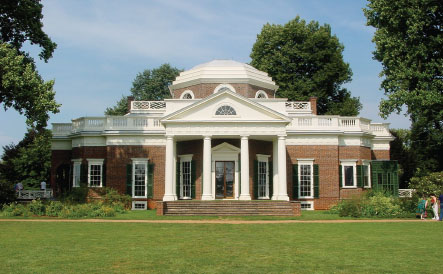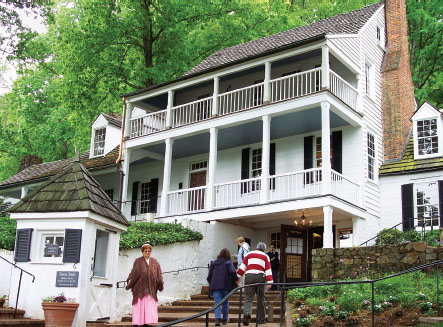Charlottesville Food (10 page)
Read Charlottesville Food Online
Authors: Casey Ireland

Zach Buckner's design of the business belies his engineer roots. A self-proclaimed empiricist, Buckner's goal for the business is to be a one-stop shop for everything a big-box store could offer. A knowledge of freight costs, business efficiency and gas prices makes Relay not only convenient to customers but ultimately a more cost-effective option for both business and consumer. Though groceries are a trillion-dollar industry with an almost limitless customer base, Buckner admits that Relay customers are particularly well-educated people interested in food quality and origin. “It just so happens that the people who are quickest to understand what we're doing are people that have college degrees,” Buckner states. Even Relay's more than forty-five employees have an unusually high level of education, matching their enthusiasm for business with individualized savviness that contributes to a tightknit team. College graduates with four languages under their belts have driven grocery trucks, while MBAs man the desks.
Though CSAs and gourmet grocery stores have a niche local appeal, Relay has its eyes on a larger piece of the grocery industry pie. With bases in Richmond, Charlottesville, Williamsburg, Baltimore and Washington, D.C., the company is the largest online food marketplace in the mid-Atlantic region.
89
Buckner's goal for the company is not an overblown monopoly; it's something far more idealistic. “I would love to see a Charlottesville that had no strip malls and no big-box stores,” Buckner muses. He looks forward to creating “the day when good food is flowing to houses around Charlottesville at something more like that ten cents per ton per mile instead of that forty-five dollars per ton per mile.” “The traffic in Charlottesville is decimated,” he continues rhapsodically, “and there's farming and baking and making chocolate.” It's not too challenging to imagine that his Pleasantville reverie could actually impact the landscape of the area, with more and more grocery items being listed every day that consumers can purchase in a more efficient, convenient matter.
G
OING TO
M
ARKET

Entrance to the Saturday City Market in downtown Charlottesville.
Photo by Kevin Haney
.
But convenience isn't the deciding factor in grocery store selection for many people who prefer a more communicative, collaborative market environment. The traditional marketplace image, filled with people, fragrances, noises and tastes, appears on a converted parking lot every Saturday from April to December. The farmers' market can be as simple as a couple vendors intermingling in a small space behind a college building or as large and complex as the four-day bonanza at Union Square Market. In Charlottesville, farmers' markets have been in full swing since at least 1972, when a man named George Cason ran for the Charlottesville City Council. His platform included a plan for a new, accessible farmers' market, “a place where the public could purchase locally grown foods sold by the growers themselves.”
90
The city's assistant manager quickly latched onto Cason's concept, despite his defeat in the election, and soon began hatching a plan for the market's design.
Agriculture and food production was, for Cason as well as many others, a family affair from the beginning. “I've been in the produce business all my lifeâmy daddy was too,” Cason noted. In 1973, he and his three brothers began the market, initially the only vendors selling. Cason and two of his brothers still sell at the farmers' market, though a Cason nephew has been banned due to being overly “boisterous.”
91
The City Market's current layout and statusâa welcoming, exciting place for both locals and visitorsâmeets Cason's conception of the market. “I just knew it would turn out like this,” Cason muses, “that it would be a nice place for people to come and meet each other and enjoy the morning.”
People have been enjoying the morning at the City Market for over forty years now. It's a place to grab breakfast, whether a fresh-made omelet or piping-hot donuts with a side of Shenandoah Joe's coffee. It's a place to meet friends, whether you go with a gaggle of fellow UVA students or take the whole family, newborns included. It's a small business incubator; many local businesses that started out as a stall at the City Market now run good-sized and well-known operations, such as Carpe Donut or Barefoot Bucha.
Perhaps most of all, it's a Charlottesville signature. First-year students at the university place excited phone calls to parents, telling them about the bustling parking lot downtown where they spentâand ate awayâmost of their Saturday morning. Young professionals bring home gifts of sage and pork sausage for the holidays, informing their families about the vendor from whom they purchased their breakfast. People from different counties, social backgrounds and professions all show up on Saturday morningsâor Wednesday and Thursday eveningsâto partake in the ritual of buying groceries direct from vendors.
Stephanie Andregg-Maloy, current manager of the City Market, has been almost single-handedly responsible for the market's success and relevancy in the twenty-first century. When she came on board in 2003, the market was much smaller, with forty to fifty vendors. She wanted part-time work and hadn't realized the city ran the market, given that it wasn't well advertised and there was no visible structure. The thought of improving the market was interesting to Andregg-Maloy, and its Saturday-based work allowed for time with her son.
The market, more than anything, needed organizational skills and management skills. She wanted the market to be “more of a business than a chaotic gathering.”
92
The first month was chaosânon-reserve vendors would just show up and make lines on First Street. People would arrive at 1:00 or 2:00 a.m. and sleep in their cars in order to get a spot. It didn't make sense for farmers, given that “stuff will go bad.” Farmers lined up for visibility and business, which the central location in a parking lot on Water Street downtown enabled. This spot on Water Street has been “in transition” and “temporary” for many years, which causes “anxiety for the vendors because of spatial insecurity.” Though numerous city meeting and citizen petitions have ensued, the City Market has remained in the same spot, albeit a “temporary one,” since 1993. Andregg-Maloy allows that while the market has always had a good reputation, it's only gotten better.
Andregg-Maloy's priorities for the current market are produce, fruits and prepared foods. Andregg-Maloy is quick to point out that while the Charlottesville City Market has changed over the years, it still remains true to Cason's vision of a place where farmers sell their produce locally. Today, farmers compose 45 percent of the vendors, selling produce, including fruits, vegetables and cut greenery; live plants; herbs; flowers; meat; poultry; eggs; and dairy products. The farmers' market also operates on Wednesday in Meade Park and Tuesday in the Forest Lakes neighborhood on Route 29, as well as smaller offshoots in the UVA hospital parking lot or around town on various days.
The occasionally high price of local goods and the well-off customer these goods normally attract have not escaped Andregg-Maloy. Since 2003, she has made it a priority to involve, not target, additional groups than the “higher class customer” who usually frequents the market. The City Market has replaced its acceptance of “local currency” with EBT cards, an initiative started by JABA in connection with its self-improvement classes. The market also interacts with Children, Youth and Family Services; Market Central is set to take over the EBT relationship in 2013. Her increased efforts to enfold more of the Charlottesville community into the vibrant local food scene will only meet increased success over the next several seasons.
The kinds of grocery retailers in the Charlottesville-Albemarle area, whether gourmet or homegrown, vary in quantity and kind. Latin food marts thrive several blocks away from the Meade Park market on Wednesday; Feast! does a solid business one street away from the affordable and popular Reid Super-Save. Whether through EBT cards, smaller packages of produce or even stands alongside roadways, retailers in Charlottesville are dedicated to getting local ingredients to a variety of home cooks eager to transform this bounty into first-rate meals. Pancetta from Olli Salumeria renders into crisp pieces for a rich amatriciana sauce, while collard greens cook down deliciously with local onions and Berkshire bacon from Edward's Ham. Salads, sauces, crumb cakes and cordials are all made tastier and more honest with the addition of local ingredients bought by local retailers from local farmers.

Downtown Charlottesville at dusk.
Photo by Sean Michael McCord
.

Thomas Jefferson's estate, Monticello.
Photo by Christopher Hollis for Wdwic Pictures
.

Peter Hatch in his garden in Crozet.
Photo by Kevin Haney
.

Michie Tavern.
Photo by Purple Flower
.

